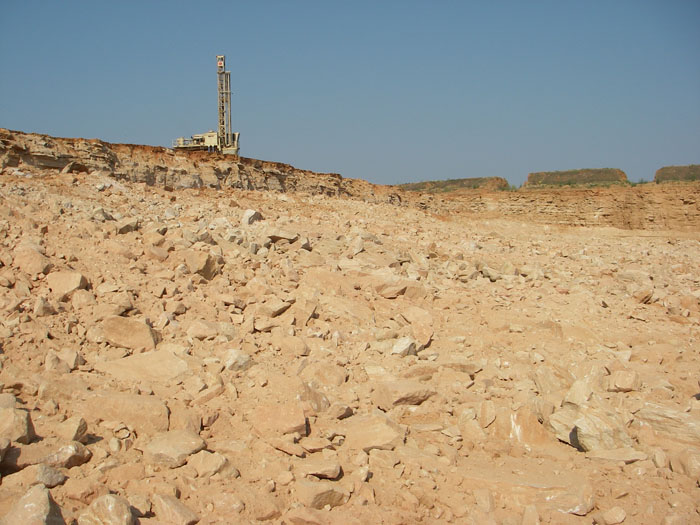Developing Frac Sand Quarries
By Thomas W. Hedrick
Silica sand is one of the most abundant minerals on the Earth’s crust. However, not any sand will work for gas and oil extraction. The industry is looking for specific gradations of sand between 1.2mm and 0.2mm. This sand should be clean, well rounded and have a Mohs hardness near 7.
Hydraulic fracturing is a key method of extracting unconventional oil and gas resources. As a rule, formations of shale gas resources have lower permeability than conventional gas formations and therefore, depending on the geological characteristics of the formation, specific technologies, such as hydraulic fracturing, are required. Although there are also other methods to extract these resources, such as conventional drilling or horizontal drilling, hydraulic fracturing is one of the key methods making their extraction technically viable. The multi-stage fracturing technique has facilitated shale gas and light tight oil production development in the United States and is believed to do so in the other countries with unconventional hydrocarbon resources. Significance of the extraction of unconventional hydrocarbons lies also in the fact that these resources are less concentrated than of conventional oil and gas resources.
The technique of hydraulic fracturing is used to increase or restore the rate at which fluids, such as natural gas, can be produced from subterranean natural reservoirs. Reservoirs are typically porous sandstones, limestones, or dolomite rocks, but also include “unconventional reservoirs” such as shale rock and coal beds. Hydraulic fracturing enables the production of natural gas and oil from rock formation deep below the earth’s surface (generally, 5,000 – 20,000 feet). At such depth, there may not be sufficient permeability or reservoir pressure to allow natural gas and oil to flow from the rock into the wellbore at economic rates. Thus, creating conductive fracture in the rock is pivotal to extract gas from shale reservoirs because of the extremely low natural permeability of shale. Fractures provide a conductive path connecting a larger volume of the reservoir to the well. So-called “super fracking”, which creates cracks deeper in the rock formation to release more oil and gas, will allow companies to frack more efficiently.
Figure 1. Frac Sand Quarry After Blast

Figure 1 shows a sandstone deposit in mid-Texas, typical of high-quality raw materials. The deposit has approximately 30 meters of overburden. The sandstone is mined, crushed and pre-graded, washed in attrition mills to further liberate the unwanted particle size both hydraulically and with vibrating screens.
The process may yield only 25% usable sand. The wet processing includes the removal of the clays and fine silica. After wet processing, the sand is dried, mechanically screened and separated into specific gradations appropriate for fracing.
Water is needed to liberate the fines. On-site water recovery, water management, clarifier and retention ponds are required. Mine permits, quarry plans, core analysis, logistics for the operations are necessary. Air quality, highway access, and use permits are all part of project development.
The frac sand user, the petroleum well driller, needs about 3,000 tons per well of sand. The driller mixes sand with other ingredients and water and injects the slurry into the well at about 50,000 psi pressure. A continuous high quality source of sand is imperative to obtain the maximum yield from the gas/oil bearing shale.
After the sand has been dried and screened, various 4 gradations of frac sand will be ready for transport to the drill site. The operation runs 24 hours per day, 7 days per week and may provide millions of tons of sand per year to customers. Logistically, this means that hundreds of pneumatic tankers of sand will be loaded, sampled, tested and released to customers each day.
To the quarry, it means that for every 5 million tons of sandstone processed each year, the mine operator must handle 3 million tons of sand tailings with reclaiming and revegetation plans.
PEC Consulting helps owners benefit from thorough planning. Our consultants have years of experience designing and operating quarries and logistics systems. We have qualified miners, engineers, materials handling experts, layout professionals and planners. Have us conceptualize and develop your deposit in this fast-growing field.
About the Author(s)
Thomas W. Hedrick
Mr. Hedrick, P.E. is a Senior Project Consultant at PEC Consulting Group. He specializes in materials handling, has been in manufacturing and engineering for 40 years, holds seven U.S. patents, and has written several dozen technical papers for various magazines and conferences around the world. Mr. Hedrick maintains a passion for excellence in client relations and project execution.
PEC Consulting Group LLC | PENTA Engineering Corporation | St. Louis, Missouri, USA
How can we help you? Get in touch with our team of experts.
